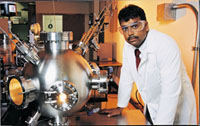by Aaron Hoover
 A Gainesville start-up has launched
an effort to market a University of Florida-developed technology aimed
at making asthma inhalers safer and more convenient to use.
A Gainesville start-up has launched
an effort to market a University of Florida-developed technology aimed
at making asthma inhalers safer and more convenient to use.
The technology involves coating the tiny drug particles contained in inhalers with a polymer 1,000 times thinner than a human hair. The coated drugs take several hours to dissolve, reducing the need for frequent inhaler use and minimizing unintended, potentially harmful release of the drugs into the blood.
Researchers with Nanocoat Technologies have successfully tested the coated particles on rats and hope to market the technology to people within the next few years.
"Pharmacists prefer drugs that patients have to take only once a day, because they tend to forget to take them at times other than the morning or evening," said Guenther Hochhaus, a UF professor of pharmaceutics. "This drug coating not only makes that possible, it also appears to have significant impact on the lung with no systemic, or reduced systemic, effects."
The process was developed after faculty and graduate students in the College of Pharmacy and the College of Engineering’s Department of Materials Science and Engineering decided to put their expertise together to come up with better asthma drugs. The professors are Hochhaus and Rajiv Singh, a professor of materials science and engineering. Others involved are Jim Fitz-Gerald, a materials science and engineering doctoral student who graduated in 1998, and Jim Talton, a recent UF doctoral recipient. Research related to the project was funded in part by UF’s Engineering Research Center for Particle Science and Technology.
Asthma afflicts 14.6 million people nationally and causes more than 5,600 deaths annually, according to the American Lung Association. The chronic disease is most common in children, with about a third of all asthma patients under the age of 18.
Many asthma drugs now on the market
are effective in alleviating the symptoms of the disease, which results
from inflammation  of
the airways, Hochhaus said. But the drugs, known as glucocorticoids, are
a form of steroid that can have serious side effects, including inhibiting
growth in children, hypertension and suppression of the immune system.
The side effects don’t result from the action of the drugs on the lung
but rather from their absorption through the lung tissue into the blood
stream. So the researchers set out to create a coating that would eliminate
or reduce the side effect.
of
the airways, Hochhaus said. But the drugs, known as glucocorticoids, are
a form of steroid that can have serious side effects, including inhibiting
growth in children, hypertension and suppression of the immune system.
The side effects don’t result from the action of the drugs on the lung
but rather from their absorption through the lung tissue into the blood
stream. So the researchers set out to create a coating that would eliminate
or reduce the side effect.
The challenges were numerous. For one thing, the coating had to be nontoxic. For another, it had to dissolve in four to six hours, or the lungs’ natural cleaning process would move the drug particles from the lungs to the throat, where they would be ingested. The coating also would have to cover each microscopic particle uniformly.
The researchers solved the puzzle through modifying a technique called pulsed laser deposition that Singh helped pioneer about a decade ago. Singh, a world expert on the technique who has authored some 150 papers about it, said it is used to make extremely thin coatings on flat surfaces in semiconductor processing. He and the others modified it to shoot a biodegradable polymer with a very high-energy laser beam into a chamber containing suspended drug particles. The entire process takes less than an hour.
"The material basically evaporates," Singh said. "It shoots out like a little jet in a shock wave and coats the drug particles."
The polymer coating, which is similar to the material used in dissolvable sutures for closing internal wounds, will require extensive testing in humans before it is approved for the marketplace, but Talton said he is confident the coating will prove benign.